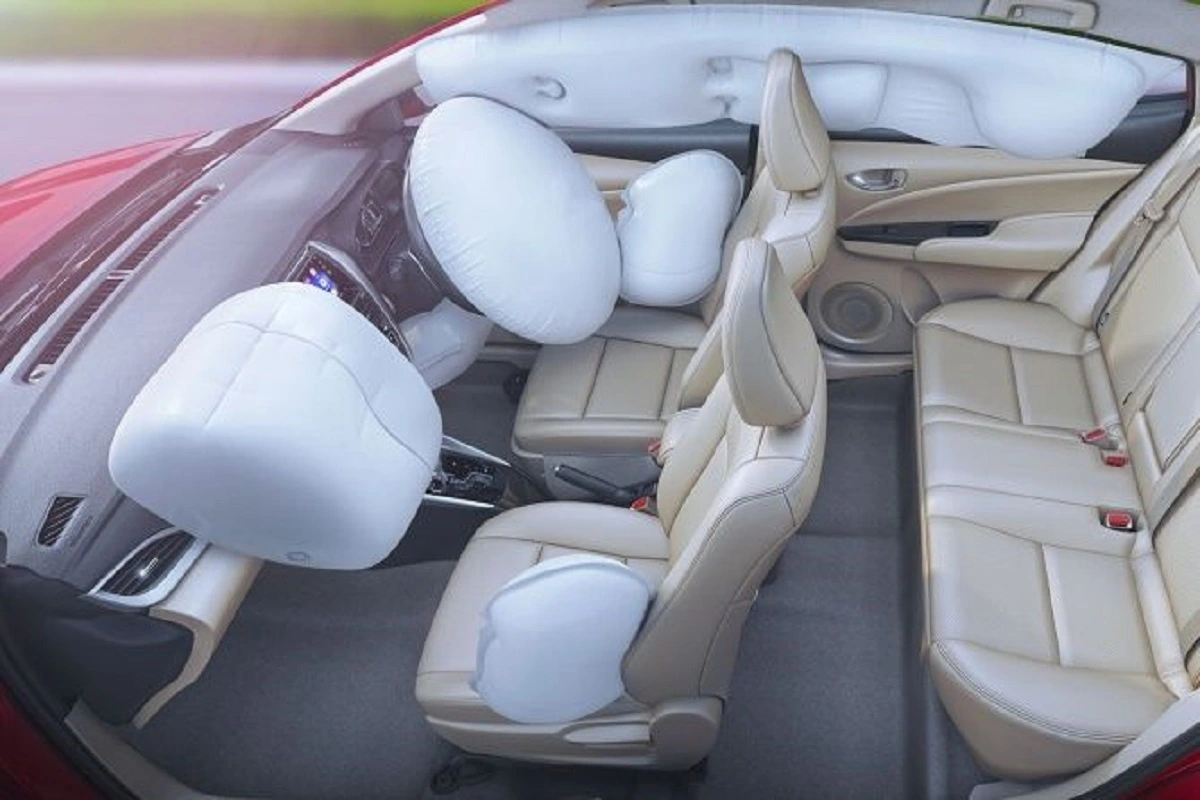The Importance of Airbags And How They Work
Airbags are crucial for vehicle safety as they protect occupants during collisions. They work by rapidly inflating and deflating within milliseconds to cushion the impact and reduce injuries.
Inflating due to sensors detecting a collision, airbags prevent occupants from hitting the hard surfaces inside a vehicle. Although they may cause minor injuries, the benefits of airbags far outweigh the risks. They are designed to work with the seat belts, providing an additional layer of protection.
We will explore the importance of airbags, their components, and how they function to ensure passenger safety on the road. So, let’s delve into the world of these life-saving devices.
Why Airbags Are Crucial For Car Safety
Airbags are crucial for car safety as they provide an added layer of protection to drivers and passengers in case of an accident. These safety devices work by rapidly inflating to cushion individuals and reduce the risk of severe injuries.
Understanding The Importance Of Airbags In Cars
Car safety is a top concern for both drivers and passengers. When it comes to vehicular safety features, airbags take center stage. These inflatable cushions play a critical role in protecting occupants during collisions and accidents. Understanding the importance of airbags in cars is essential for every car owner and driver.
Let’s explore how airbags reduce the risk of injuries and prevent fatalities.
How Airbags Reduce The Risk Of Injuries
Airbags are not just another optional feature in cars; they are a vital safety measure that can save lives. Here are some key points to highlight their significance:
- Rapid Deployment: When a collision occurs, airbags rapidly deploy within milliseconds, cushioning the impact and reducing the force exerted on occupants.
- Absorption of Energy: By absorbing the energy generated during a crash, airbags help to disperse it evenly across a larger surface area, minimizing the risk of severe injuries.
- Protection for Head and Chest: Airbags are strategically placed in the vehicle to protect the head and chest areas, which are particularly vulnerable during accidents.
- Reducing Whiplash Injuries: Airbags can help prevent whiplash injuries caused by sudden deceleration, as they provide support and minimize the jerking motion of the head and neck.
The Role Of Airbags In Preventing Fatalities
In addition to reducing the risk of injuries, airbags can play a critical role in preventing fatalities. Here’s how:
- Mitigating Head-On Collisions: Airbags provide an extra layer of protection during head-on collisions, absorbing the impact and lowering the risk of fatal head injuries.
- Protecting Against Rollovers: When a vehicle rolls over, airbags help to keep occupants in the cabin and prevent them from being ejected, which can significantly reduce the likelihood of fatalities.
- Complementing Seatbelts: Airbags work in conjunction with seatbelts to provide comprehensive protection. The combination of seatbelts and airbags greatly improves the chances of surviving an accident.
- Enhanced Safety for Children: Advanced airbag systems now include sensors that detect the presence of child passengers and deploy airbags with reduced force to avoid causing harm.
Airbags are not just crucial for car safety; they can make a significant difference in preventing injuries and saving lives. Rapid deployment, energy absorption, targeted protection, and their role in preventing fatalities make airbags an integral component of every vehicle’s safety system.
As a responsible car owner, make sure to keep your airbags well-maintained and stay informed about any recalls or updates to ensure maximum protection in the event of an accident. Stay safe on the roads!
The Working Mechanism Of Airbags
Airbags are critical safety devices in vehicles, providing protection during collisions. They work by rapidly inflating to cushion occupants from the impact, reducing the risk of severe injury or fatality.
Airbags are vital safety features installed in vehicles to protect occupants during accidents. These inflatable devices work on a sophisticated mechanism that involves precise sensor technology, rapid inflation and deflation, and different types of airbags with specific functions. Understanding how airbags work can help us appreciate their importance in ensuring our safety on the road.
Sensor Technology Behind Airbag Activation
- Sensors: Modern vehicles are equipped with sensors throughout the vehicle’s structure. These sensors can detect and measure various factors, such as sudden deceleration, impact force, and seat occupancy.
- Activation Criteria: When the sensors detect a threshold level of impact force, indicating a potential collision, they send signals to the airbag control unit (ACU).
- ACU Response: The ACU evaluates the signals received from the sensors and, based on pre-programmed algorithms, decides whether to deploy the airbags.
- Trigger Mechanism: Once the ACU determines that a collision is imminent, it sends an electric current to ignite the inflator inside the airbag module.
Rapid Inflation And Deflation: A Life-Saving Feature
- Inflation Process: When the inflator is triggered, it rapidly converts a solid chemical propellant into a large volume of gas. This gas inflates the airbag cushion in a matter of milliseconds.
- Cushion Function: The inflated airbag acts as a buffer between the vehicle’s occupants and hard surfaces, absorbing the impact force and reducing the risk of severe injuries.
- Controlled Deflation: After inflation, the airbag quickly deflates through vents to prevent the occupants from being trapped. This controlled deflation process ensures their safe exit from the vehicle post-accident.
Types Of Airbags And Their Specific Functions
- Frontal Airbags: These airbags are located on the driver and front passenger sides. They deploy during frontal collisions and provide protection for the head and chest areas.
- Side Airbags: Installed in the sides of the vehicle’s seats or door frames, side airbags are designed to protect occupants during side-impact collisions.
- Curtain Airbags: Positioned in the roof area above the windows, curtain airbags deploy during certain types of accidents. They provide protection for the heads of occupants in both frontal and side impacts.
- Knee Airbags: Situated below the steering wheel and dashboard, knee airbags are designed to reduce injuries to the lower body, particularly the knees and thighs.
- Seatbelt Airbags: Integrated into seatbelts, these airbags help to minimize the impact on the chest during accidents and provide additional restraint to prevent occupants from moving forward.
By understanding the working mechanism of airbags, including the sensor technology behind their activation, rapid inflation and deflation, and the different types with specific functions, we can appreciate the significant role they play in enhancing our safety on the road.
The continuous advancement of airbag technology ensures that these life-saving devices are constantly evolving to provide better protection during accidents.
The Evolution Of Airbag Technology
Airbag technology has come a long way, serving as a crucial safety feature in vehicles. By rapidly inflating during impact, airbags protect passengers from severe injuries, highlighting their importance in ensuring road safety. Understanding how airbags work can shed light on their evolution and essential role in vehicle design.
Airbags have come a long way since their introduction in the 1970s. Over the years, advancements in technology have greatly improved their effectiveness in protecting vehicle occupants during collisions. From single airbags to advanced systems, let’s explore the evolution of airbag technology.
From Single Airbags To Advanced Systems
In the early days, vehicles were equipped with only a single airbag, typically located in the steering wheel for the driver. However, as automotive manufacturers recognized the need for improved safety measures, airbags began to appear in other parts of the vehicle as well.
Here’s a breakdown of the evolution of airbag systems:
- Frontal Airbags: The initial focus was on frontal airbags, which deploy from the steering wheel and passenger side dashboard. These airbags provide protection in head-on collisions.
- Side Airbags: As the understanding of crash dynamics grew, side airbags were introduced to address the risks posed by side impacts. These airbags deploy from the seat or door, offering protection for the head and torso.
- Curtain Airbags: Curtain airbags, also known as head or roof airbags, were developed to provide additional protection in side collisions. They deploy from above the side windows, creating a protective cushion for occupants’ heads.
- Knee Airbags: Knee airbags were introduced to reduce lower leg injuries. Deploying from below the dashboard, they provide cushioning and restraint for the lower limbs during a crash.
Intelligent Airbag Systems And Their Benefits
With the advancement of electronic systems, airbag technology has become more intelligent and adaptive. Here are some key benefits of these intelligent airbag systems:
- Multi-Stage Deployment: Modern airbag systems can adjust airbag deployment based on the severity of the impact. This helps to mitigate the risk of injury by deploying with appropriate force tailored to the crash conditions.
- Occupant Detection: Intelligent systems incorporate occupant detection sensors to determine the presence and position of occupants within the vehicle. This allows for optimized airbag deployment, reducing the risk of injury from unnecessary airbag deployment.
- Adaptive Restraints: Some advanced systems use sensors and data analysis to determine the optimal timing and force for seatbelt pretensioning and airbag deployment. This personalized approach provides enhanced protection tailored to each occupant.
- Crash Sensor Integration: Intelligent systems integrate various crash sensors located throughout the vehicle to provide a comprehensive understanding of the collision’s dynamics. This allows for more precise deployment and increased effectiveness in protecting occupants.
Latest Innovations In Airbag Design
Continual research and innovation have led to the development of cutting-edge airbag designs. These innovations aim to enhance occupant safety and address specific types of collisions. Here are some notable advancements:
- Pedestrian Airbags: Automotive manufacturers have introduced external airbags that deploy from the vehicle’s front end to protect pedestrians in the event of a collision. These airbags reduce the risk of head and leg injuries.
- Center Airbags: To prevent occupant-to-occupant collisions in side-impact scenarios, center airbags have been developed. These airbags deploy from the door panel or the side of the driver or front passenger seat, acting as a barrier between the occupants.
- Inflatable Seatbelts: Combining the benefits of airbags and seatbelts, inflatable seatbelts are designed to distribute crash forces over a wider area of the body. They offer enhanced protection for rear-seat passengers, reducing the risk of injury to the chest and neck.
Airbag technology has significantly evolved over the years, transitioning from single airbags to advanced systems equipped with intelligent features. These developments, along with the latest innovations in airbag design, continue to enhance occupant protection and improve safety on the road.
Factors Influencing Airbag Effectiveness
Airbag effectiveness is influenced by various factors such as the speed of impact, seating position, and proper functioning. Understanding how airbags work and their importance in providing safety during accidents is crucial for every vehicle owner.
Speed And Angle Of Collision: Its Impact On Airbag Performance
- Speed and angle of collision greatly impact the effectiveness of airbags in a vehicle. Let’s delve into how these factors influence airbag deployment and performance:
- Speed of Collision: Airbags are designed to deploy within milliseconds of a collision. The speed at which a vehicle is moving directly affects the force exerted during impact. Higher speeds can result in more severe collisions, requiring airbags to deploy more forcefully to adequately protect occupants.
- Angle of Collision: The angle at which a vehicle collides with an object or another vehicle also plays a significant role. Frontal collisions are the most common, but side-impact and rear-end collisions can also occur. Airbags must be able to detect the angle of collision accurately to provide optimal protection.
Proper Seat Belt Usage And Airbag Synergy
- Proper seat belt usage is crucial to maximizing the effectiveness of airbags. Here’s why seat belts and airbags work together synergistically to enhance safety:
- Seat Belt Restraint: Seat belts restrain occupants and prevent excessive movement during a collision. They help keep occupants in the correct position for the airbags to deploy effectively. Without wearing seat belts, the risk of injury may increase, as occupants can collide with the airbags at a wrong angle or be propelled out of the vehicle.
- Airbag Cushioning: While seat belts provide restraint, airbags serve as a supplemental safety measure. They cushion and distribute the force of impact, reducing the risk of severe injuries. When used together, seat belts and airbags offer a comprehensive safety approach for vehicle occupants.
Vehicle Safety Ratings And Airbag Effectiveness
- Vehicle safety ratings play a vital role in determining the overall effectiveness of airbags. Consider the following factors when evaluating airbag performance:
- Crash Testing: Organizations like the National Highway Traffic Safety Administration (NHTSA) and the Insurance Institute for Highway Safety (IIHS) conduct rigorous crash tests to assess a vehicle’s safety. These tests evaluate how well the airbags perform in different collision scenarios, providing valuable insights for potential buyers.
- Safety Features: Modern vehicles often include advanced safety features that work in conjunction with airbags. Systems such as forward collision warning, automatic emergency braking, and lane departure warning can help prevent accidents or mitigate their severity. These technologies complement airbags and enhance overall vehicle safety.
Remember, understanding the factors influencing airbag effectiveness is essential for making informed decisions when choosing a vehicle and ensuring passenger safety. By considering elements such as speed and angle of collision, proper seat belt usage, and vehicle safety ratings, you can prioritize safety on the road.
Stay tuned for more essential information about airbags and their impact on vehicle safety.
Common Myths And Misconceptions About Airbags
Airbags play a vital role in vehicle safety by protecting passengers during accidents. Clearing up misconceptions, it’s important to understand how airbags work to ensure their proper functioning and maximize their potential in safeguarding passengers’ lives.
Dispelling The Myth Of Dangerous Airbag Deployments
Airbags are a critical safety feature in vehicles, designed to provide protection in the event of a collision. However, there are several common myths and misconceptions surrounding airbags that may cause concern or confusion. Let’s take a closer look at these misconceptions and separate fact from fiction.
Myth: Airbags Replace The Need For Seat Belts
- Airbags are not a substitute for seat belts; rather, they work in conjunction with them to maximize safety.
- Seat belts are the primary restraint system in a vehicle, preventing occupants from colliding with the interior or being ejected from the vehicle.
- Airbags are designed to complement seat belts by providing additional cushioning and protection in the event of a crash.
- Both seat belts and airbags should always be used together for optimal protection.
Addressing Misconceptions About Airbag Injuries
While airbags are designed to save lives and reduce the risk of injury during accidents, there are a few misconceptions about airbag deployments and potential injuries. Let’s debunk some of these myths:
- Airbags cause more harm than good: False. While airbags can cause some minor injuries, such as abrasions or bruises, when they deploy, they significantly reduce the risk of more severe injuries, such as head trauma or fractures.
- Airbags are dangerous for children: False. Modern vehicles are equipped with advanced sensors that detect the presence and weight of occupants. If a child is correctly restrained in an age-appropriate car seat in the rear seat, the risk of harm from an airbag deploying is minimal.
- Airbags can suffocate you: False. Airbags deflate within milliseconds of deployment. They are designed to protect and then quickly deflate, giving the occupants enough space to breathe.
- Airbags always deploy in minor accidents: False. Airbags are triggered by specific collision thresholds, typically requiring a certain level of force to activate. In minor fender-benders or low-speed accidents, airbag deployment may not be necessary.
It’s important to be aware of these facts to ensure a proper understanding of airbag safety. By dispelling these common myths, we can appreciate the crucial role airbags play in safeguarding vehicle occupants during accidents.
Remember, maintaining your vehicle’s airbags, ensuring they are in proper working condition, and always wearing your seat belt are essential for maximizing your safety on the road.
Maintenance And Care For Airbags
Airbags are vital safety features in vehicles that protect occupants during impacts. Understanding how airbags work and maintaining them properly is crucial for their effectiveness. Regular inspections and replacements, following manufacturer guidelines, can ensure that airbags are in optimal condition, ready to deploy and save lives when needed.
Regular Inspections: Ensuring Airbag Reliability
- Have a professional mechanic conduct regular inspections on your airbags to ensure they are functioning properly.
- Inspections should be performed according to the manufacturer’s guidelines, typically every two years or after a collision.
- During an inspection, the mechanic will check the airbag’s sensors, wiring, and connections for any signs of wear or damage.
- They will also inspect the inflation system to ensure the airbag can deploy effectively in the event of an accident.
- Regular inspections can help identify any issues with the airbag system early on and prevent potential malfunctions or failures.
Replacing Deployed Airbags: A Crucial Safety Measure
- If your airbags have been deployed during a collision, it is crucial to replace them immediately.
- Deployed airbags cannot be reinstalled or reused, as their effectiveness is compromised after deployment.
- When replacing airbags, make sure to use genuine parts from the vehicle manufacturer or reputable suppliers.
- Replacing deployed airbags should always be done by a certified mechanic to ensure proper installation.
- Neglecting to replace deployed airbags can significantly affect the safety of both the driver and passengers.
Common Mistakes To Avoid With Airbag Maintenance
- Avoid attempting any repairs or maintenance on your airbag system unless you are a trained professional.
- Do not disconnect or tamper with the airbag system, as this can lead to the airbag not deploying during an accident.
- Avoid buying used airbags, as they may be ineffective due to age, damage, or improper storage.
- Do not place heavy objects or obstruct the airbag deployment areas in the vehicle, as this can hinder their functionality.
- Stay informed about any recalls or safety bulletins related to your vehicle’s airbag system and take immediate action if necessary.
Remember, regular inspections, prompt replacement of deployed airbags, and avoiding common mistakes can ensure the reliability and effectiveness of your vehicle’s airbag system in the event of an accident. Stay proactive in maintaining and caring for your airbags to prioritize the safety of yourself and your passengers.
Future Advances In Airbag Technology
Airbag technology is constantly evolving to enhance safety on the road. Discover the importance of airbags and how they function in preventing injuries during accidents. Stay informed about the future advancements that aim to further improve this critical automotive safety feature.
Integrated Airbag Systems: Expanding Safety Features
Airbag technology has come a long way since its inception, evolving to include integrated systems that enhance safety features. Here are some key advancements in this area:
- Integration with Seatbelts: The integration of airbags with seatbelts is a major leap in safety technology. By combining these two crucial components, the impact of a collision can be significantly reduced. When a crash is detected, the integrated system simultaneously deploys the airbag and activates the seatbelt pretensioner, instantly restraining the occupants and minimizing the risk of severe injuries.
- Side Airbag Curtains: Traditional airbags primarily focus on frontal impact protection, but advances in integrated airbag systems now extend safety features to include side airbag curtains. When a side collision occurs, these airbags deploy from the roof lining, creating a protective barrier between the occupants and potential intrusions. This provides an extra layer of safety, especially in scenarios where the occupants’ heads or torsos are at risk.
- Front Airbag Tech: The latest integrated airbag systems have also improved the design and functionality of front airbags. Rather than deploying with a single force, these advanced airbags can adapt and deploy in different stages based on the severity of the impact. This approach ensures that the airbags provide optimal protection to the driver and passengers in varying crash scenarios.
Predictive Technology: Anticipating Crashes And Mitigating Damage
The future of airbag technology lies in its ability to anticipate and actively respond to potential crashes. Here are some exciting developments in the field of predictive technology:
- Pre-Crash Sensors: Vehicles equipped with pre-crash sensors can detect when a collision is imminent, allowing the airbag system to prepare for impact in advance. These sensors analyze crucial data such as the distance and speed of nearby vehicles, braking patterns, and other relevant factors. By providing an early warning system, these predictive sensors ensure that the airbags are fully deployed and ready to protect the occupants prior to impact.
- Advanced Crash Algorithms: Modern airbag systems utilize advanced crash algorithms that can accurately assess the severity and type of collision. This enables the airbags to react with the necessary force and timing, mitigating the damage caused by different crash scenarios. By fine-tuning the response of the airbag system, these algorithms enhance safety and reduce the risk of injuries.
- Sensing Obstacles and Pedestrians: Expanding beyond the protection of vehicle occupants, future airbag technology aims to protect pedestrians and cyclists as well. Advanced sensors integrated into the front of vehicles can now detect obstacles or potential collisions with pedestrians and cyclists. In the event of an imminent impact, these sensing systems deploy specialized airbags that cover the vehicle’s exterior, reducing the risk of severe injuries to those outside the vehicle.
Enhancing Protection For Pedestrians And Cyclists
Airbag technology is not limited to safeguarding vehicle occupants. Considerable efforts are being made to enhance protection for pedestrians and cyclists on the road. Here are some critical developments in this area:
- External Airbags: External airbags have been designed to deploy on the outside of a vehicle in the event of an unavoidable crash with a pedestrian or cyclist. These airbags act as a cushioning barrier, absorbing impact and minimizing the risk of severe injuries. By focusing on the safety of those outside the vehicle, this technology showcases a significant step forward in reducing pedestrian and cyclist fatalities.
- Vehicle-to-Pedestrian Communication: To further improve safety for pedestrians, airbag systems are being integrated with vehicle-to-pedestrian communication technology. Using sensors and algorithms, the vehicle can detect the presence of pedestrians in its vicinity. In the event of a potential collision, the airbag system can deploy and communicate with the pedestrian, warning them audibly or visually, allowing them to react and potentially avoid the impact.
- Cyclist Detection and Protection: Airbag technology is also being developed to specifically cater to the safety of cyclists. Advanced sensors can recognize the presence of cyclists near the vehicle and calculate their proximity and movement patterns. In the event of a crash, specialized airbags can deploy from the vehicle to provide additional impact protection for the cyclist, reducing the risk of severe injuries.
As airbag technology continues to evolve, integrated systems, predictive technology, and enhanced protection for pedestrians and cyclists will play a pivotal role in further improving vehicle safety and reducing the impact of collisions. By constantly pushing the boundaries of innovation, the future of airbag technology remains promising in making the roads safer for everyone.

Credit: www.mackinsab.com
Frequently Asked Questions Of The Importance Of Airbags And How They Work
What Is The Importance Of Airbag?
Airbags are a crucial safety feature as they provide protection during a car collision.
What Are Airbags And How Do They Work?
Airbags are safety devices that protect passengers during a car crash. They work through sensors detecting impact, inflating bags instantly to cushion occupants.
What Are 5 Facts About Airbags?
Airbags are safety devices in vehicles that inflate upon impact, providing cushioning and protection. They reduce the risk of injuries in accidents. Airbags rely on sensors to deploy at the right timing. They work in conjunction with seat belts to increase safety.
Proper maintenance is crucial to ensure airbags function effectively.
What Would Happen If Airbags Are Not Used In Cars?
Not using airbags in cars can result in increased risk of severe injuries or even death during accidents.
Conclusion
Airbags play a crucial role in ensuring the safety of passengers during a car accident. By deploying rapidly upon impact, they provide a cushioning effect that reduces the risk of serious injuries and fatalities. These life-saving devices work by utilizing a combination of sensors, inflation systems, and impact sensors to detect the severity of a collision and deploy the airbags accordingly.
Modern airbag systems have continued to evolve and improve over the years, incorporating advanced technologies to enhance their effectiveness. From front airbags to side airbags and even knee airbags, manufacturers are constantly striving to provide the highest level of protection for occupants.
It is important for car owners and drivers to understand the significance of airbags and ensure that they are functioning correctly. Regular maintenance and checks, along with proper seat belt usage, can greatly contribute to the overall safety of a vehicle.
Airbags are a crucial safety feature that should never be overlooked. Investing in a vehicle equipped with airbags and utilizing them correctly can significantly reduce the risk of injuries and save lives during car accidents. Therefore, it is essential to prioritize the presence and proper maintenance of airbags in every vehicle.





